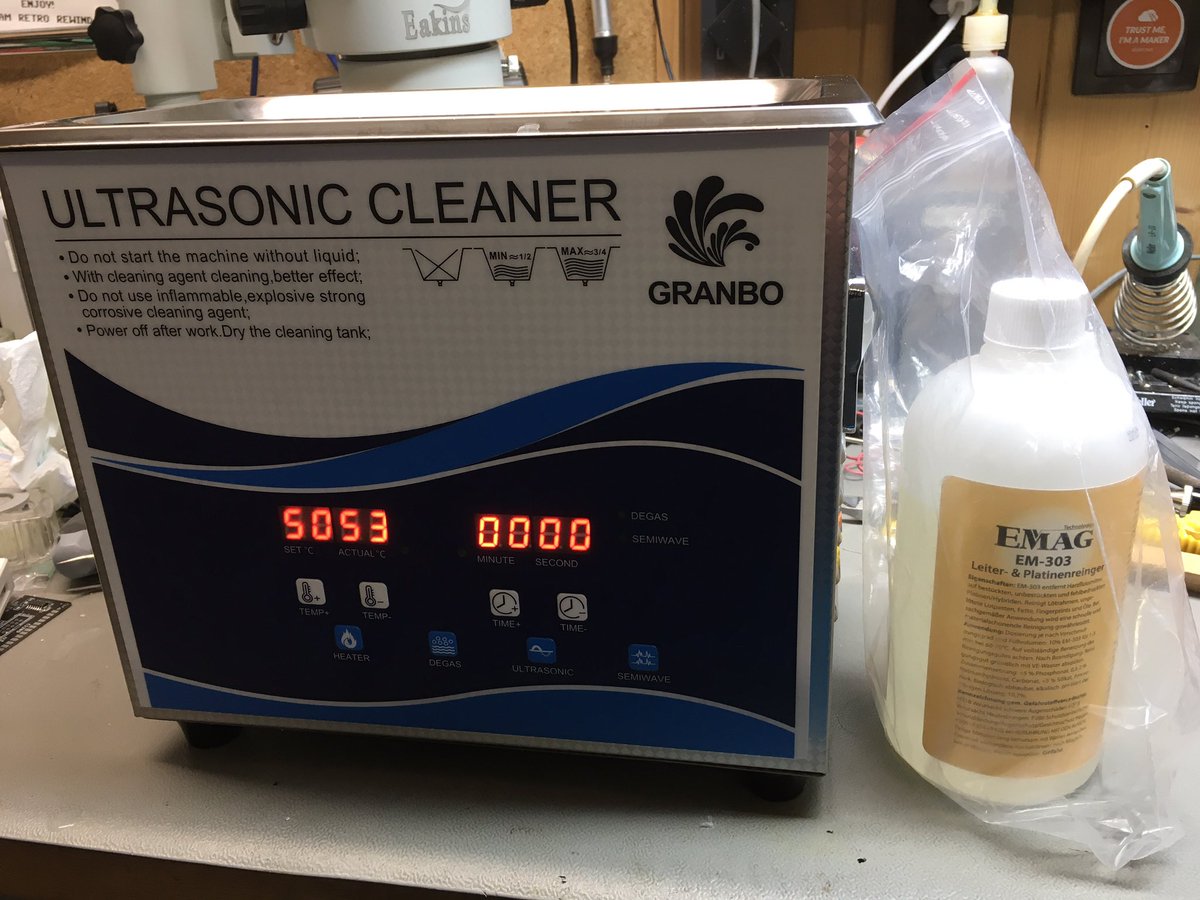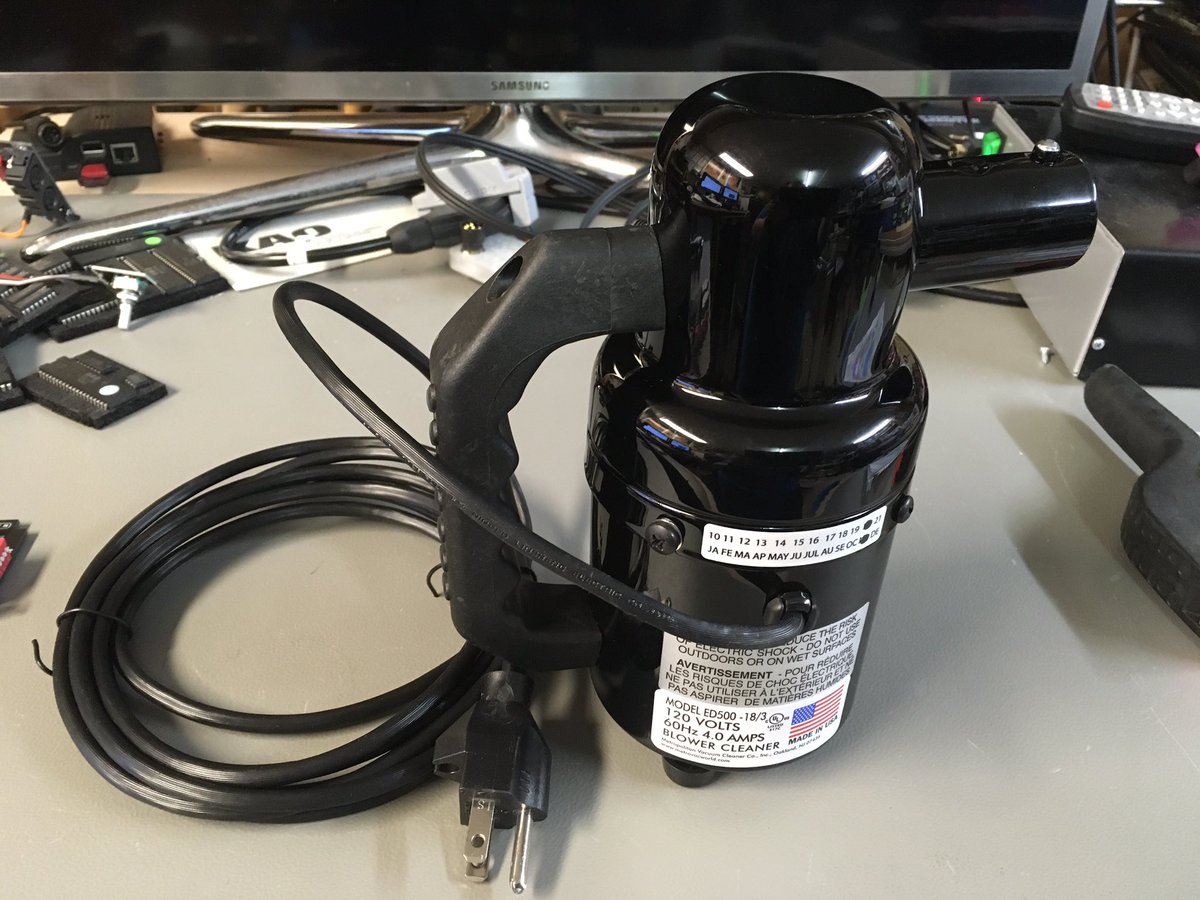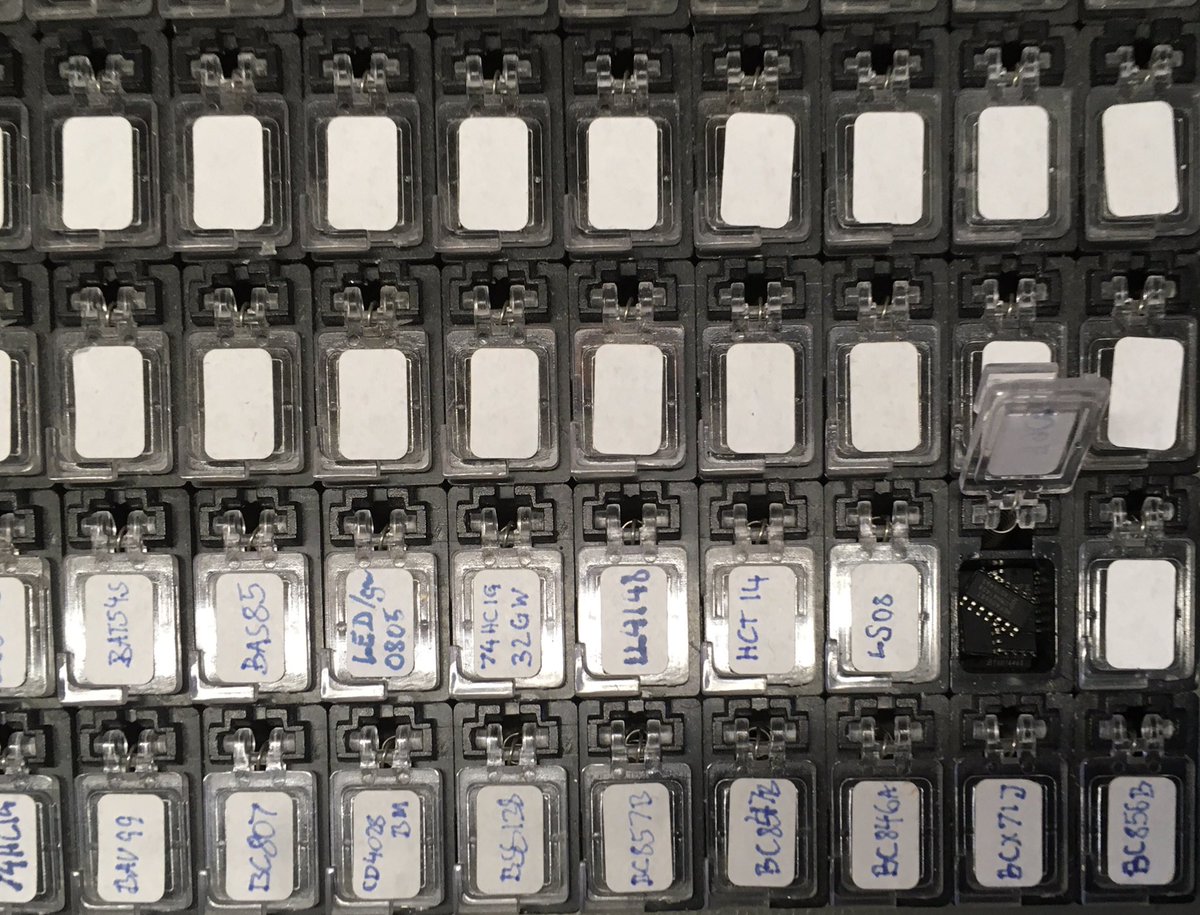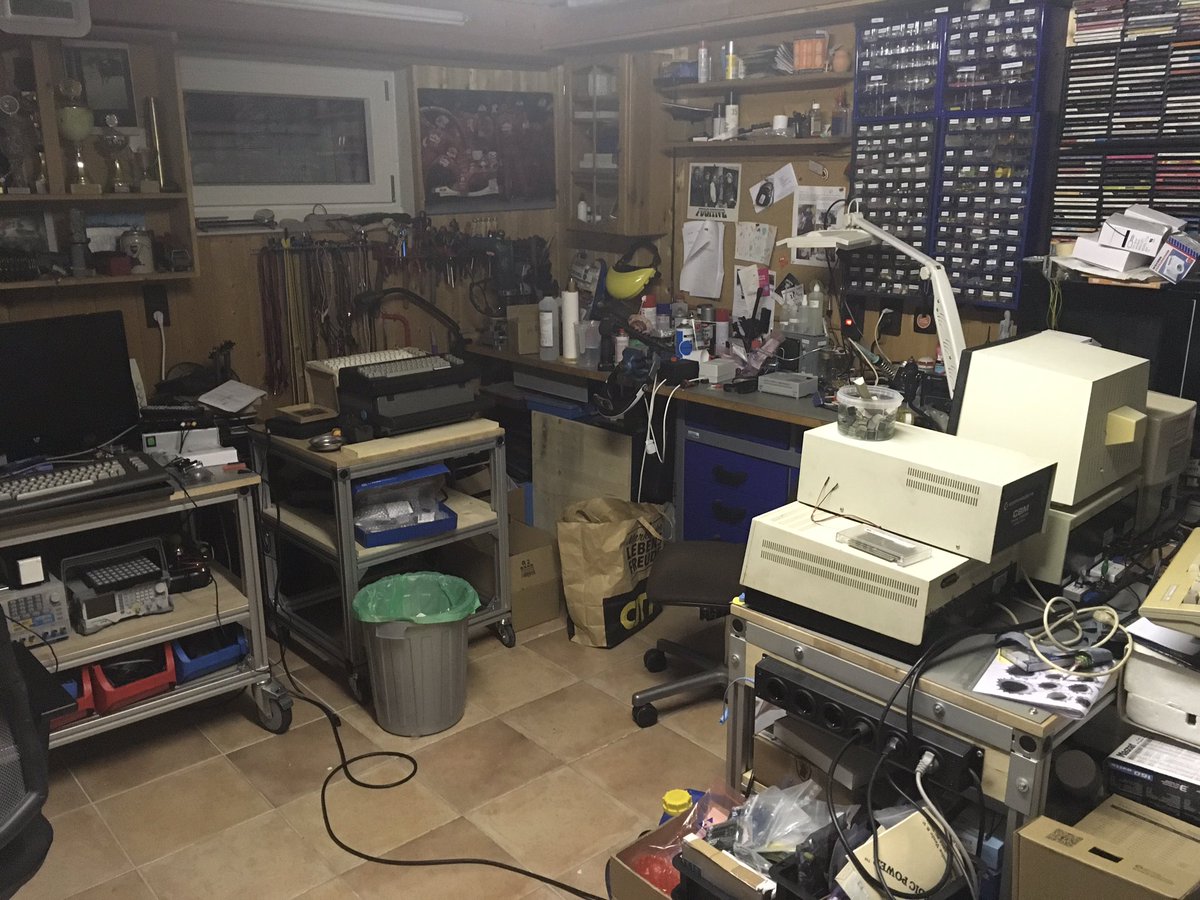I just went through all the pictures on my iPad, sorting them and there are many pictures of #lab #equipment, that I have gathered over the decades. Most is useful, some is not. Maybe, I should tweet a bit about the good stuff. I am sure, I have mentioned some, already. 

What I really like, are the DIY lab trolleys. The fact, that they are on wheels let me rearrange my lab easily. They all have electric outlets installed and an ESD table cover. All the same height, made from aluminum extrusion profiles. #labTrolley 







It is even easy to set up a macro photo tent on such a lab trolley. I take most pictures with the iPad, but sometimes, it is niche to have better quality pictures of projects and things. 

My #multimeters are in daily use. Most jobs don’t require a fancy multimeter, a 20€ one is absolutely ok. The Fluke is my classic, traditional one (I had the same model at work). My #eevBlog 121GW (I have two of those) is, what I use most of the time. 

My fancy 350MHz scope is something, I use sometimes, not every day, it depends on the project. For most (retro computer) jobs, a 50MHz or 100MHz dual channel scope is good enough. A cheap 1MHz handheld scope is not. #oscilloscope 



A lab power supply or several are required. This one is fancy (2+1 channels are not). My cheap 0-30V, 0-10A (QW-MS3010D ) is also a useful thing. I would not really want to use it for paid projects. #labPSU 

The signal generator is nothing, that I use very often. It depends on the project. For audio repairs, it is great, but a less fancy one would be good enough. #signalGenerator 

My trusty #Weller WECP-20 #soldering station serves me since 1991 in endless hours of use. The hot air station is not in use often. Mostly for shrinking sleeves (@ 150°C). My desoldering gun is something, that I don’t want to miss anymore. The hot plate is still new to me… 







… The hot plate seems to be a great, great thing for #SMD soldering. 10cm x 10cm might be good enough for most hobby projects. The solder pot is another tool for desoldering stubborn stuff with big ground pins. Requires kapton tape for masking. #soldering #hotPlate #solderPot 

I have been using too small #solderTips for a too long time in my life. I usually used the finest. Now, I use the middle one, because the heat transport is not great in a small one. Most of the time, I use leaded solder for my hobby projects. 





As flux, I usually use liquid SMD flux (Keinath KFM24 XLO) most of the time. Sometimes a flux gel (AMTECH NC-559-ASM) is also useful. 



Most of the time, I am using isopropanol and my ESD brushes for #cleaning up the #PCBs after soldering. That‘s quick and good enough. The #ultrasonic cleaner takes time to set up (and heat up), one pcb load requires 6-10 minutes with a special solvent. 



The #ultrasonic cleaner might also destroy mechanic components like crystals or reed relays. Some components are not suitable for washing.
My crimp tools are something, I don’t want to miss. They are so useful. Cable making without is a drag! The Engineer PA09, PA-20 and the IWISS IWS-2820M, some no name for faston and IWISS SN-28B and SN-025 #crimpTool 







I know, that the SN-28B is sold for #DuPont terminals. The result is shitty, though. The SN-025 is perfect for DuPont terminals. It has a round shape for the wire crimp. The SN-28B is great for Molex KK terminals. I use these two tools most of the time, now.
The high voltage probe is great for debugging CRTs. It also works for discharging the tubes. Since I don’t do this frequently, it is a nice to have tool. 

The (400€) #microscope is a good thing for #soldering. It is a fancy tool, though. Most of us are sooner or later suffering from being far sighted, so a (20€) head band #magnifier is a pretty good solution for the problem. It is my daily driver! 



I had a magnifier lamp on my work bench, but I never really got along with it. With USB microscopes, I am lacking of contrast and the third dimension for working.
The FLIR camera is nice to have, but not really required. The temperature reading is only good, if the right emissivity (=never). The thermo couple is the way to go, I think. 





Things, I never thought, I would require before I picked up the Commodore hobby. The chip extractor is nice. I do use screwdrivers for levering out ICs. And the leg straightener. I had one at work, but did not use it in 20 years. 



This #tool is for scraping off the lacquer insolation of wire for winding inductors and transformers. 

This is a great tool for getting out stubborn screws. @thilographie_de recommended it. 



The electronic load. Good for testing power supplies and batteries. #electronicLoad 

The LCR meter is a nice to have tool. IMHO measuring the ESR of old capacitors only makes sense if you have a data sheet to compare it to the original parameter. 

The TL866 is a nice programmer for the money. Not just for EPROMs, for my job, I am only using serial programmers. 



This wire pen is a cool thing for per boards. It is a special wire with an insulation, that melts when it is soldered. Before PCBs became cheap, I have built test equipment and circuits that I wanted to evaluate this way. The wire is wrapped around the pins, then, it is soldered. 







The dust blower is also useful. I use it more for blowing isopropanol off the PCBs after soldering and cleaning. Unfortunately 120V (I had to get a transformer) and ESD is IMHO not required in a hobby lab. 



The #Backbit chip #tester is a useful thing for testing (Commodore) #ICs, RAMs and logic ICs (74xx, 40xx). Definitely worth to buy. I‘d like to know the test procedures, though. I had some chips reported good (6522), that were not working and bad, when they worked ok. 

It is possible, that the bad ICs were bad in the situ, though. And that the good ICs were not used with all their features.
In the 1980s my dad was a good customer of the Commodore technical service in Kiel, so I had contact with one repair guy there. He told me about the bad sockets used by Commodore and to clean the IC pins with a glass fiber pen. The tuner spray is a good treatment for sockets. 



My measuring things. I like my calipers without a battery. There is also a marking gauge, which I don’t use very often. Usually, I make a case construction, that I print out, tape to the case and mark the cut outs. It is not perfect, but usually good enough. 





My storage… the ordinary drawer magazines, for SMD parts, I am using „mouse toilets“. Very handy, since you can store 1000s of components in a narrow space. I keep my resistor assortment in a folder with collector cards inlays. Oh, and I have those SMD sample books. 







My lab liquids. SMD liquid flux is what I use a lot. Isopropanol for cleaning. Freeze spray for debugging heat introduced problems, well tuner spray. I don’t use canned air anymore. 

My Soldapullt is a pretty good solder sucker. I rarely use it, since the desoldering station is pretty good. 

My 3D printer. I have love/hate relationship with it. Whenever I have to print something important, it fails. I have tried hard to become a great 3D printer user. I failed. My skills improved for two weeks, after that, I only got more confused 🤣🤣🤣🤣 

My cut plotter. A nice thing. Cutting out labels manually is a drag. Unfortunately, the Brother CM900 does not recognize register marks. Position the cut lines manually each time. No real fun. 



• • •
Missing some Tweet in this thread? You can try to
force a refresh









